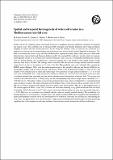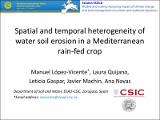Por favor, use este identificador para citar o enlazar a este item:
http://hdl.handle.net/10261/92134COMPARTIR / EXPORTAR:
 SHARE
BASE SHARE
BASE
|
|
| Visualizar otros formatos: MARC | Dublin Core | RDF | ORE | MODS | METS | DIDL | DATACITE | |

| Campo DC | Valor | Lengua/Idioma |
|---|---|---|
| dc.contributor.author | López-Vicente, Manuel | - |
| dc.contributor.author | Quijano Gaudes, Laura | - |
| dc.contributor.author | Gaspar Ferrer, Leticia | - |
| dc.contributor.author | Machín Gayarre, Javier | - |
| dc.contributor.author | Navas Izquierdo, Ana | - |
| dc.date.accessioned | 2014-02-20T10:31:05Z | - |
| dc.date.available | 2014-02-20T10:31:05Z | - |
| dc.date.issued | 2012-04 | - |
| dc.identifier.citation | European Geosciences Union (EGU). General Assembly (Vienna, Austria. 22–27 April 2012) | es_ES |
| dc.identifier.citation | Geophysical Research Abstracts 14: EGU2012-9435 (2012) | es_ES |
| dc.identifier.uri | http://hdl.handle.net/10261/92134 | - |
| dc.description | 2 .pdf files: 1 .pdf with the abstract of contribution published in the EGU Abstracts Journal; 1 .pdf (13 Pags., Figs.)copy of the oral presentation by the authors. | es_ES |
| dc.description.abstract | Fertile soil loss by raindrop impact and runoff processes in croplands presents significant variations at temporal and spatial scales. The combined use of advanced GIS techniques and detailed databases allows high resolution mapping of runoff and soil erosion processes. In this study the monthly values of soil loss are calculated in a medium size field of rain-fed winter barley and its drainage area located in the Central Spanish Pre-Pyrenees. The field is surrounded by narrow strips of dense Mediterranean vegetation (mainly holm oaks) and grass. Man-made infrastructures (paved trails and drainage ditches) modify the overland flow pathways and the study site appears hydrologically closed in its northern and western boundaries. This area has a continental Mediterranean climate with two humid periods, one in spring and a second in autumn and a dry summer with rainfall events of high intensity from July to October. The average annual rainfall is 495 mm and the average monthly rainfall intensity ranges from 1.1 mm / h in January to 7.4 mm / h in July. The predicted rates were obtained after running the RMMF model (Morgan, 2001) with the enhancements made to this model by Morgan and Duzant (2008) to the topographic module, and by López-Vicente and Navas (2010) to the hydrological module. A total of 613 soil samples were collected and all input and output maps were generated at high spatial resolution (1 x 1 m of cell size) with ArcMapTM 10.0. A map of effective cumulative runoff was calculated for each month of the year with a weighted multiple flow algorithm and four sub-catchments were distinguished within the field. The average soil erosion in the cultivated area is 1.32 Mg / ha yr and the corresponding map shows a high spatial variability (s.d. = 7.52 Mg / ha yr). The highest values of soil erosion appear in those areas where overland flow is concentrated and slope steepness is higher. The unpaved trail present the highest values of soil erosion with an average value of 72.23 Mg / ha yr, whereas the grass and forested areas have annual rates lower than 0.1 Mg / ha yr. The highest values of soil erosion appear in March, April, May, October and November showing a very good correlation with the depth of monthly rainfall (Pearson’s r = 0.97) and a good correlation with the number of rainy days per month (Pearson’s r = 0.76). However, no correlation was obtained with the values of monthly rainfall intensity. The availability of a detailed database of soil properties, weather values and a high resolution DEM allows mapping and calculating the spatial and temporal variations of the soil erosion processes within the cultivated area and the area surrounding the crop. Thus, the application of soil erosion models at high spatial and temporal resolution improves their predicting capability due to the complexity and large number of relevant interactions between the different sub-factors. | es_ES |
| dc.language.iso | eng | es_ES |
| dc.rights | openAccess | es_ES |
| dc.title | Spatial and temporal heterogeneity of water soil erosion in a Mediterranean rain-fed crop | es_ES |
| dc.type | presentación | es_ES |
| dc.description.peerreviewed | Peer reviewed | es_ES |
| item.openairetype | presentación | - |
| item.grantfulltext | open | - |
| item.cerifentitytype | Publications | - |
| item.openairecristype | http://purl.org/coar/resource_type/c_18cf | - |
| item.fulltext | With Fulltext | - |
| item.languageiso639-1 | en | - |
| Aparece en las colecciones: | (EEAD) Comunicaciones congresos | |
Ficheros en este ítem:
| Fichero | Descripción | Tamaño | Formato | |
|---|---|---|---|---|
| Lopez-VicenteM_EGU12-Assambl-2-Abst_2012.pdf | EGU Abstract | 38,23 kB | Adobe PDF |  Visualizar/Abrir |
| Lopez-VicenteM_EGU12-Assambl-2-Pres_2012.pdf | Oral Presentation by the Authors | 2,86 MB | Adobe PDF |  Visualizar/Abrir |
CORE Recommender
Page view(s)
191
checked on 23-abr-2024
Download(s)
214
checked on 23-abr-2024
Google ScholarTM
Check
NOTA: Los ítems de Digital.CSIC están protegidos por copyright, con todos los derechos reservados, a menos que se indique lo contrario.
